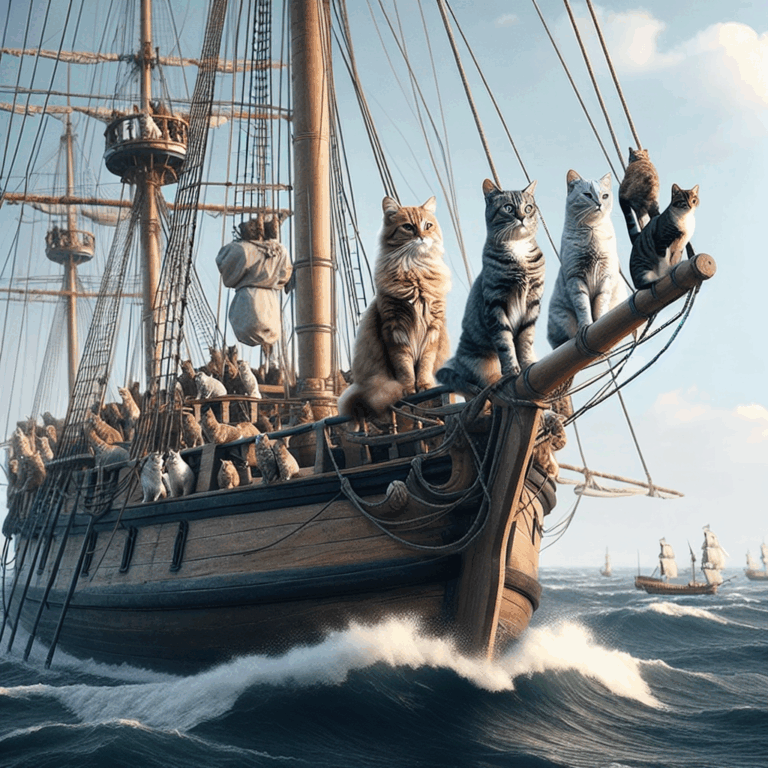The Feline Navigators: Cats and Their Role in Maritime History
- No Comments
The world of maritime history is often dominated by tales of daring sailors and epic voyages across uncharted waters. However, one of the most overlooked yet significant contributors to life at sea has been the humble cat. For centuries, cats have played an essential role on ships, serving as both companions and vital members of the crew. Their presence aboard these vessels has impacted naval expeditions, trade routes, and the development of seafaring traditions in ways that few may fully appreciate.
Dating back to ancient times, cats have been revered by mariners for their natural hunting instincts, which they used to control the rodent populations aboard ships. Rats and mice posed a significant threat to the safety and health of crew members, as these pests could destroy food supplies, spread disease, and even damage the ship’s structure by gnawing on ropes and wooden hulls. The inclusion of cats on ships proved to be a practical solution, as these agile predators efficiently kept vermin at bay, ensuring a safer and more comfortable journey.
Beyond their practical utility, cats also provided emotional support to sailors who spent long months away from home. The companionship of a feline friend offered a sense of normalcy and comfort amidst the vast, unpredictable oceans. Cats were often seen as good omens by sailors, their presence believed to bring good luck and favorable winds. Some superstitions even suggested that a ship with a cat was protected from storms and shipwrecks, adding to the mystique and reverence surrounding these seafaring felines.
Historically, cats have been recorded on some of the most legendary voyages. The famous HMS Beagle, which carried Charles Darwin on his journey that would lead to the development of the theory of evolution, had its own ship’s cat. Likewise, the infamous pirate Blackbeard was said to have kept several cats on his ship, considering them vital to his success. These stories underscore the importance of cats not only as practical allies but also as integral parts of maritime lore.
As trade routes expanded across the globe, cats aboard trading vessels inadvertently contributed to the spread of domesticated felines worldwide. They were introduced to new territories, where they adapted to different environments and became part of local cultures, thus influencing the biodiversity of regions far from their original homes.
In modern times, while the role of cats at sea has diminished due to technological advancements and changes in maritime practices, their legacy endures. Museums dedicated to naval history often feature exhibits on the lives of ship’s cats, and their stories continue to captivate the imagination of maritime enthusiasts. The tradition of cats aboard ships has also inspired countless works of literature and art, further cementing their place in the tapestry of human history.
In conclusion, the role of cats in maritime history is a testament to their adaptability and enduring partnership with humans. These feline navigators not only safeguarded ships from the perils of the sea but also enriched the lives of countless sailors with their companionship. As we reflect on the vast ocean of history, the contributions of these silent yet steadfast travelers remind us of the profound impact cats have had on our journey across the waves.

The world of maritime history is often dominated by tales of daring sailors and epic voyages across uncharted waters. However, one of the most overlooked yet significant contributors to life at sea has been the humble cat. For centuries, cats have played an essential role on ships, serving as both companions and vital members of the crew. Their presence aboard these vessels has impacted naval expeditions, trade routes, and the development of seafaring traditions in ways that few may fully appreciate.
Dating back to ancient times, cats have been revered by mariners for their natural hunting instincts, which they used to control the rodent populations aboard ships. Rats and mice posed a significant threat to the safety and health of crew members, as these pests could destroy food supplies, spread disease, and even damage the ship’s structure by gnawing on ropes and wooden hulls. The inclusion of cats on ships proved to be a practical solution, as these agile predators efficiently kept vermin at bay, ensuring a safer and more comfortable journey.
Beyond their practical utility, cats also provided emotional support to sailors who spent long months away from home. The companionship of a feline friend offered a sense of normalcy and comfort amidst the vast, unpredictable oceans. Cats were often seen as good omens by sailors, their presence believed to bring good luck and favorable winds. Some superstitions even suggested that a ship with a cat was protected from storms and shipwrecks, adding to the mystique and reverence surrounding these seafaring felines.
Historically, cats have been recorded on some of the most legendary voyages. The famous HMS Beagle, which carried Charles Darwin on his journey that would lead to the development of the theory of evolution, had its own ship’s cat. Likewise, the infamous pirate Blackbeard was said to have kept several cats on his ship, considering them vital to his success. These stories underscore the importance of cats not only as practical allies but also as integral parts of maritime lore.
As trade routes expanded across the globe, cats aboard trading vessels inadvertently contributed to the spread of domesticated felines worldwide. They were introduced to new territories, where they adapted to different environments and became part of local cultures, thus influencing the biodiversity of regions far from their original homes.
In modern times, while the role of cats at sea has diminished due to technological advancements and changes in maritime practices, their legacy endures. Museums dedicated to naval history often feature exhibits on the lives of ship’s cats, and their stories continue to captivate the imagination of maritime enthusiasts. The tradition of cats aboard ships has also inspired countless works of literature and art, further cementing their place in the tapestry of human history.
In conclusion, the role of cats in maritime history is a testament to their adaptability and enduring partnership with humans. These feline navigators not only safeguarded ships from the perils of the sea but also enriched the lives of countless sailors with their companionship. As we reflect on the vast ocean of history, the contributions of these silent yet steadfast travelers remind us of the profound impact cats have had on our journey across the waves.


